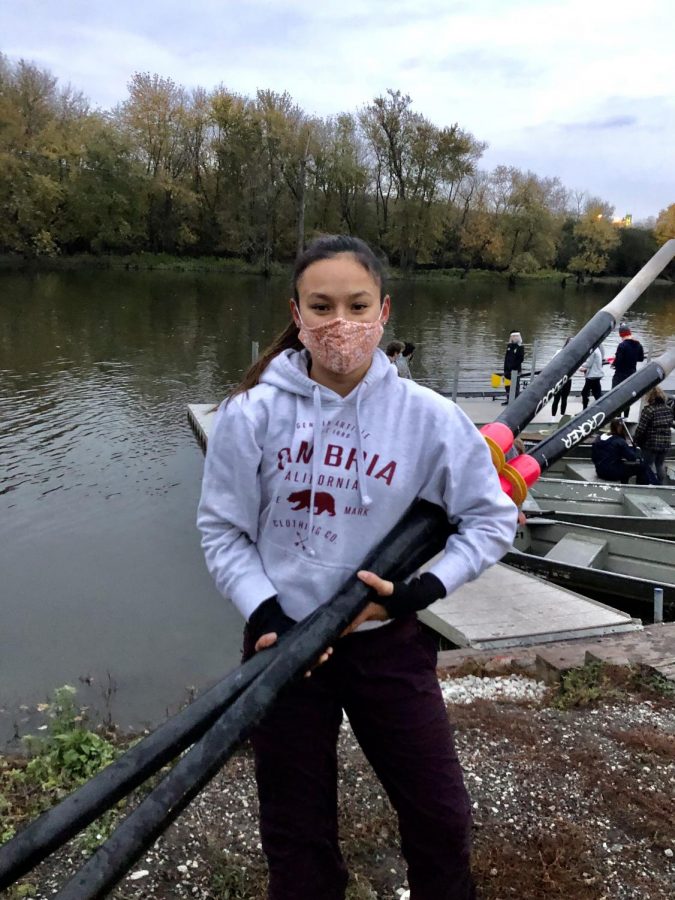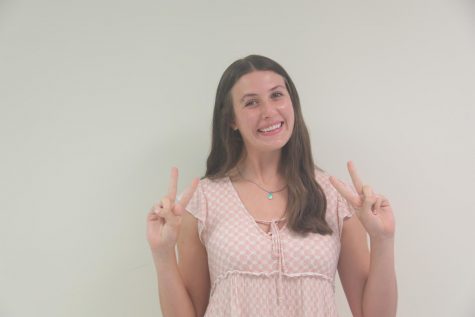Student joins local rowing team
November 10, 2020
Charlotte Sands ‘22 never anticipated dedicating upwards of 12 hours a week to the vigorous sport of rowing. What started as a recreational activity for Sands evolved into a competitive commitment, she said. Sands started taking rowing lessons with her parents at the Chicago Rowing Foundation (CRF) this past summer. After falling in love with rowing during her lessons, Sands eagerly accepted the offer to join CRF’s west (suburban) high school team, Sands said.
“At first it took a lot for me to get my strength up,” Sands said. “I also had to learn how to work together with other people to move in the same rhythm.”
The sport of rowing requires a tremendous amount of commitment, power, coordination and strength in an athlete, head coach and director of the CRF west team Emily Caflisch said. Athletes sit in a boat with two, four or eight rowers and work together to propel the boat by synchronously rowing. There are two types of rowing: sculling done with two oars and sweeping done with one oar. After joining the novice team—made up of first-year rowers—Sands switched from the sculling she had practiced in her summer lessons, to sweeping.
“Charlotte came to us with a strong athletic background, but I think she is still getting used to refining her sweeping technique,” Caflisch said. “However, I have already seen an improvement in her fitness.”
In order to build strength and endurance, Sands uses a rowing machine called an ergometer, Caflisch said. The ergometer mimics the rowing strokes done in the water. With the machine, Sands and her teammates are able to see their strokes per minute and how far they would have traveled in the water. The athletes will also use the erg (short for ergometer) when the water level at their practice location on the Des Plaines River in Lemont is too low to row on.
“Erging has helped me learn some perseverance because it is really hard work,” Sands said. “You basically just have to get through the pain.”
Sands’s teammates, including Cailin Reising ‘23, appreciate the effort Sands puts forth in and out of the water.
“Charlotte’s really nice and will talk to people around her, so she definitely just wants everyone to do their best,” Reising said. “When we’re doing a hard workout she encourages others and tells people they are doing a good job.”
Teamwork is a crucial part of rowing. In Sands’s boat of eight rowers, everyone works together to assemble the boat, row together in the water and safely carry the boat back on land, Sands said.
Sands’s teammates come from other schools besides LT in the Chicago suburbs including Hinsdale Central, York, and Glenbard East. Since they are first year rowers many of them are freshman and sophomores. As a junior on the novice team, some of the younger athletes look up to Sands, Caflisch said.
“I have noticed some younger novices feeling comfortable staying closer to her side,” Caflisch said. “I did have a conversation with Charlotte about being a role model to the other girls, and that went well, as she seemed receptive.”
Due to COVID-19, Sands and her team have not participated in competitions this fall. However, they have participated in practice scrimmages against CRF’s city team where they did not declare a winner. Winter season is all indoor training, but they are hopeful competitions will take place this spring, Sands said.
In the future, Sands hopes to grow as an athlete on her high school team and is considering rowing recreationally in college, she said.
“We hope that Charlotte pushes herself to her best each day, and we’ll see where that takes her with the sport,” Caflisch said.





















![Movie poster for '[Rec]" (2007).](https://www.lionnewspaper.com/wp-content/uploads/2023/04/rec-640x900.jpg)



